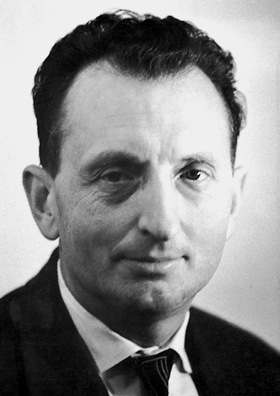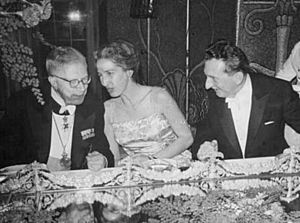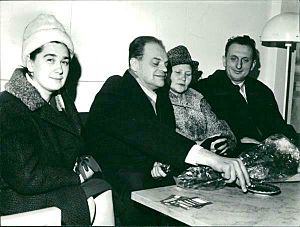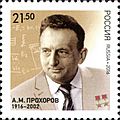Alexander Prokhorov facts for kids
Quick facts for kids
Alexander Prokhorov
|
|
|---|---|

Prokhorov in 1964
|
|
| Born |
Alexander Michael Prochoroff
11 July 1916 Peeramon, Queensland, Australia
|
| Died | 8 January 2002 (aged 85) |
| Resting place | Novodevichy Cemetery, Moscow |
| Known for | Lasers and masers |
| Awards | 1964 Nobel Prize in Physics 1987 Lomonosov Gold Medal |
| Scientific career | |
| Fields | Physics |
Alexander Mikhailovich Prokhorov (born Alexander Michael Prochoroff; 11 July 1916 – 8 January 2002) was a famous Soviet-Russian physicist. He was born in Australia. He is best known for his important work on lasers and masers. For this pioneering research, he shared the Nobel Prize in Physics in 1964. He shared the award with Charles Hard Townes and Nikolay Basov.
Contents
Early Life and Education
Alexander Michael Prochoroff was born on July 11, 1916, in Peeramon, Queensland, Australia. His parents were Russian revolutionaries. They had moved from Russia to escape the strict rule of the tsar (the emperor of Russia). As a child, he went to Butchers Creek State School.
In 1923, his family moved back to Russia after the October Revolution and the Russian Civil War. In 1934, Prokhorov began studying physics at Saint Petersburg State University. He was a member of the Komsomol, a youth organization in the Soviet Union, from 1930 to 1944.
Prokhorov graduated with high honors in 1939. He then moved to Moscow to work at the Lebedev Physical Institute. There, he studied how radio waves travel in the ionosphere. The ionosphere is a part of Earth's upper atmosphere that helps radio signals bounce around the world.
World War II Service
When World War II started for the Soviet Union in June 1941, Prokhorov joined the Red Army. He fought as an infantry soldier and was wounded twice. He received three medals for his bravery, including the Medal For Courage in 1946. He left the army in 1944 and returned to the Lebedev Institute. In 1946, he earned his Ph.D. (a high-level university degree). His Ph.D. work was about how to keep the frequency of a tube oscillator (a device that creates electrical signals) stable.
Groundbreaking Research in Physics
In 1947, Prokhorov began studying a special type of light called "coherent radiation." This radiation is made by electrons moving in a circular path inside a machine called a synchrotron. A synchrotron is a type of particle accelerator that speeds up tiny particles. Prokhorov showed that this radiation was mostly in the microwave range. Microwaves are a type of radio wave, like those used in microwave ovens. His findings became the basis for his next big research paper in 1951.
By 1950, Prokhorov was a leader in the oscillation laboratory. He started a team of young scientists to study how molecules rotate and vibrate. This led to their work in quantum electronics.
Developing Masers and Lasers
In 1954, Prokhorov became the head of his laboratory. Working with Nikolay Basov, he developed the ideas for a "molecular oscillator." They built one using ammonia. This device was a very early version of what we now call a maser. A maser is like a laser, but it produces microwaves instead of visible light. They also found a way to create "population inversion." This is a key step needed to make masers and lasers work. Their discoveries were first shared in 1952 and published in 1954–1955.
In 1955, Prokhorov started researching electron paramagnetic resonance (EPR). This involves studying how electrons in certain materials react to magnetic fields. While studying ruby (a red gemstone), he realized it could be used to create a laser. In 1958, he suggested a new design for a laser called an "open type" cavity. This design is still widely used today.
For his amazing work on masers and lasers, Alexander Prokhorov received the Nobel Prize in Physics in 1964. He shared it with Nikolay Basov and Charles Hard Townes.
Important Roles and Awards

In 1959, Prokhorov became a professor at Moscow State University, a very important university in the Soviet Union. The same year, he won the Lenin Prize. In 1960, he became a member of the Russian Academy of Sciences. He was elected a full Academician in 1966.
He received the Order of Lenin five times (in 1967, 1969, 1975, 1981, and 1986). This was a very high award in the Soviet Union. In 1968, he became the vice-director of the Lebedev Institute. In 1971, he became the head of a laboratory at the Moscow Institute of Physics and Technology. He was also elected a member of the American Academy of Arts and Sciences in 1971.
Between 1982 and 1998, Prokhorov was the acting director of the General Physics Institute of the Russian Academy of Sciences. After 1998, he became its honorary director. After he passed away in 2002, the institute was renamed the A. M. Prokhorov General Physics Institute in his honor.
In 1969, Prokhorov was named a Hero of Socialist Labour. This was the highest award in the Soviet Union for achievements in the economy and culture. He received this honor a second time in 1986. From 1969 onwards, he was the chief editor of the Great Soviet Encyclopedia, a major Russian encyclopedia.
He also received international awards, such as the Frederic Ives Medal in 2000, which is the highest award from the Optical Society of America. He became an Honorary Member of the OSA in 2001. The same year, he received the Demidov Prize.
Alexander Prokhorov died on January 8, 2002, in Moscow. He was buried at the Novodevichy Cemetery.
Family Life
Prokhorov married Galina Shelepina, a geographer, in 1941. They had a son named Kiril, who was born in 1945. Following in his father's footsteps, Kiril Prokhorov also became a physicist. He now leads a laser-related laboratory at the A. M. Prokhorov General Physics Institute.
Honours and Awards
- Lenin Prize (1959)
- Five Orders of Lenin
- Order of the Patriotic War, 1st class (1985)
- Nobel Prize in Physics (1964)
- Hero of Socialist Labour, twice (1969, 1986)
- Medal For Courage
- USSR State Prize (1980)
- Order of Merit for the Fatherland, 2nd class (1996)
- State Prize of the Russian Federation (1998)
- Frederic Ives Medal (2000)
- Demidov Prize (2001)
- Lomonosov Gold Medal (1987)
- State Prize of the Russian Federation in science and technology (2003, awarded after his death)
- Many military and jubilee medals
Books
- A. M. Prokhorov (Editor in Chief), J. M. Buzzi, P. Sprangle, K. Wille. Coherent Radiation Generation and Particle Acceleration, 1992, ISBN: 0-88318-926-7.
- V. Stefan and A. M. Prokhorov (Editors) Diamond Science and Technology Vol 1: Laser Diamond Interaction. Plasma Diamond Reactors (Stefan University Press Series on Frontiers in Science and Technology) 1999 ISBN: 1-889545-23-6.
- V. Stefan and A. M. Prokhorov (Editors). Diamond Science and Technology Vol 2 (Stefan University Press Series on Frontiers in Science and Technology) 1999 ISBN: 1-889545-24-4.
Images for kids
See also
 In Spanish: Aleksandr Prójorov para niños
In Spanish: Aleksandr Prójorov para niños



